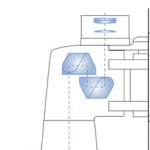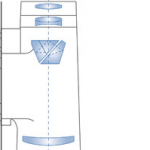There are many types of binoculars on the market. For every outdoor or action sport there is a customized version. Think of hiking, water sports, observation of animals, hunting, mountain sports and many other types of activities.
In order to choose binoculars that best meet your needs, it is necessary to compare the technical properties of the different models. Here are some topics that will help you in your search.
Zwaluw 10×50 Vogelbescherming Nederland
Binoculars
Subjects in this GearGuide:
- Parts
- Types
- Choices
- Technology
- Roof & Porro prism’s
- Focusing
- Zoom factor & Field of sight
- Lenses & Coatings
Parts
- Eyepiece with coating
- Eyepiece
- Roof prism
- Inside filled with nitrogen to prevent condensation
- Objective
- Bridge
- Casing (glass fibre /aluminium/plastic)
- Centralization with integrated diopters
- Eyepiece adjustement mechanism
Types
Listed below you will find a brief description of types of binoculars that are particularly suitable for outdoor and action sports use.
Compact binoculars
Verrekijkers van een relatief klein formaat en laag gewicht die gemakkelijk in een zak van je jack of in het documentenvak bovenop je rugzak passen.
Mono binocular
Binocular with one tube that combines the modest size of the compact viewer with the sharpness of an observation viewer.
Observation viewers
Binoculars that are made to view objects at a long distance and in a wide range of viewpoints.
Zoom binoculars
Binoculars that bring an object even closer than possible with other viewers via a steplessly adjustable mechanism.
Night viewers
Binoculars that allow you to detect the details of an object in low light or poor visibility.
Choosing binoculars
Choosing binoculars is difficult because there will never be one that meets all your requirements. If you want to use him as wide as possible, choose the binoculars that offer the greatest common denominator of all your wishes and desires.
If you choose a compact viewer, because as the outdoor sportsman’s you value low weight and a modest size, the trade-off will be that some aspects of the image quality is less than an observation binocular.
Besides dividing binoculars in a number of main categories (compact viewers, observation viewers, night visioners, etc.), manufacturers also divide their viewers into subcategories, based on specific features. In addition, these features indicate a degree of suitability, ranging from ‘less suitable’ to ‘optimal fit’. In this manner, the binoculars that are best suited to you are much easier to find.
Technology
It’s useful to make a rough pre-selection before purchasing binoculars. There are other factors that determine your ultimate choice. The budget may be an important factor in the final choice.
For example, what are your thoughts on things like durability (material, construction, etc.), watertightness, size and weight?
But also subjective issues like: how does a viewer feel in your hand, how does it feel when you place it against our eyes or glasses, does he feel comfortable wearing the strap around your neck, can you carry it on your belt or backpack for easy access?
Because you get a lot of terminology and technical aspects when making the rough pre-selection we will discuss these below. Moreover, technical features determine the quality of the viewer and therefore the price and will impact your choice.
Subjects:
- Roof & Porro prism’s
- Focus
- Zoom factor & Field of View
- Lenses & Coatings
Roof & Porro prism’s
These are terms that relate to the construction and the interior of your binoculars. As far as fabrication goes, binoculars can be divided into two main groups: roof viewers and porro-viewers.
In the case of roof-viewers, recognizable by the straight tubes, the lenses are in line with each other. Due to their narrower construction, they are more compact than porro-viewers. Porro-viewers are narrow nearer the
Porro-viewers are narrow nearer the eyepiece side and wider at the front. The lenses are not in line with each other. Prisms (triangularly shaped lenses) refract the light (read: image)so that you do not have the idea that you’re looking at an angle but straight ahead. The latter will find it more fun to hold a narrow binocular while the other is more likely to hold a slightly wider viewer. A porro viewer is not by definition qualitatively superior to a roof viewer or vice versa.
Porro prism’s
 You will find porro-prims’s in most binoculars. The body contains two prisms left and right, with the objective lenses screwed onto the body. Due to the fact that with a porro-viewer the lenses are further apart, the depth of a porro-viewer is larger than that of a viewer with roof prisms. The image quality of the best porro-prism is similar to that of the best viewers with roof-prisms. A porro-viewer is generally cheaper.
You will find porro-prims’s in most binoculars. The body contains two prisms left and right, with the objective lenses screwed onto the body. Due to the fact that with a porro-viewer the lenses are further apart, the depth of a porro-viewer is larger than that of a viewer with roof prisms. The image quality of the best porro-prism is similar to that of the best viewers with roof-prisms. A porro-viewer is generally cheaper.
Roof prism’s
 Binoculars with prisms in a slim shape have the eyepiece and objective aligned. As a result, they are more compact, but the depth of vision is somewhat less. The manufacture of binoculars with roof prisms is more expensive than the manufacture of porro-binoculars.
Binoculars with prisms in a slim shape have the eyepiece and objective aligned. As a result, they are more compact, but the depth of vision is somewhat less. The manufacture of binoculars with roof prisms is more expensive than the manufacture of porro-binoculars.
Focus
For all binocular binoculars, a hinge between the tubes allows the width of the binoculars to match the individual distance between the eyes. In addition, they have a focus dial which allows the eyepiece and lens to be adjusted so that the object, whether near or distant, can be focussed on. An additional adjustment option is offered by the eyepiece correction, consisting of a
An additional adjustment option is offered by the eyepiece correction, consisting of a stepless adjustable ring on the eyepiece of the two tubes. Often the eyesight in both your eyes in not the same. With this correction option, that difference can be evened out. Using the +/- scale, you can remember how to set the eyepiece next time, if your binoculars are used by others as well.
For those of us that wear glasses, many binoculars have additional adjustment options. To compensate for the distance between the eye and the spectacle glass (the eyepiece is not directly on the eyes), the eyepieces can slide in a few millimeters or, in the case of a rubber eye ring, be folded over.
Zoom Factor & Field of View
On binoculars, the zoom factor and sometimes the field of vision, expressed in degrees, are mentioned. The zoom factor of a binoculars is expressed in a simple formula – two numbers connected by an ‘x’ symbol. 8 x 40 means nothing more or less than that object in enlarged 8 times and the diameter of the objective lens is 40 mm. Together they make the zoom factor. The lower the zoom factor, the closer the object, but intensity of light will also be lower and the vibration sensitivity will be higher.
If you use your binoculars mainly during the day a 7 or 8 times zoom binoculars with an objective diameter of 20 to 30 mm will be enough to achieve the best image quality. If light conditions are worst conditions, a 7 to 10 times zoom with a lens diameter of 40mm or greater offers a good alternative. The bigger the diameter of the lens, the more light will enter the binoculars.
Field of view
This is the width of the landscape observed through the binoculars. A bigger field of view offers more comfort when looking through your binoculars. The field of view is defined at 1000 m and can be given in degrees or in meters. It is good to know that 1 ° = 17.40 m. We speak of a wide-angle binoculars from a viewpoint of 110 m, thus from 6.32 °.
Lenses & Coatings
The quality of the lenses and their alignment is very important for the imaging of binoculars. This explains that the prices of binoculars can be far apart. For example, if the lenses are not well-cut, the image may be sharp, but not at the edges. Your brains will always try to compensate the viewer’s mistakes. That means that using a bad pair of binoculars will tire you more quickly than using a good pair.
Coatings
Coatings are used to reduce the loss of light through reflections of the lenses. A viewer with a good coating, therefore has a greater brightness than a viewer with the same magnification and objective diameter, without coatings. Generally, the following indications are applied to coatings:
Coated (C) – only the objective is coated
Fully Coated (FC) – All lenses and prisms are coated
Fully Multi Coated (FMC) – The lenses and prisms are provided with multiple coatings
FMC binoculars give the most clarity, contrast and color precision.
Binoculars with roof-prisms are sometimes provided with anti-phase shifting coatings. These ensure that the image at the edges becomes sharper.



